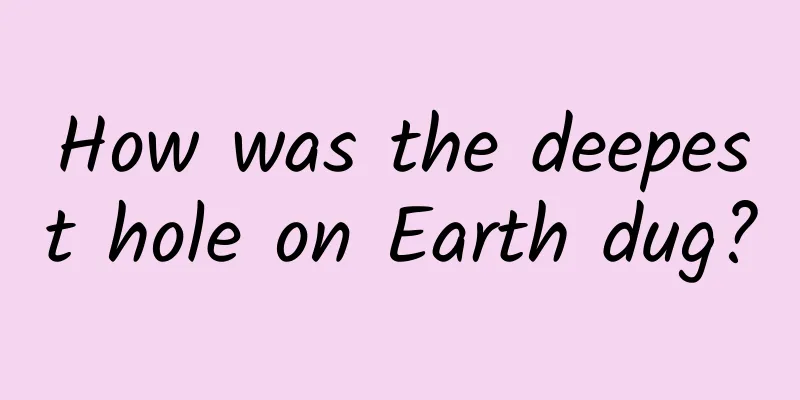How was the deepest hole on Earth dug?

|
Author: Gui Youyu Reviewer: Zhou Yingcao, Chief Engineer of PetroChina Technology Research Institute Which is harder, exploring space or digging a hole in the ground? The answer is "It's hard to go up to the sky, and it's also hard to go down to the ground." The probes launched into space by humans have flown out of the solar system and are more than 20 billion kilometers away from us. The deepest hole dug by humans on Earth is less than 13 kilometers. The diameter of the Earth where humans live is 12,742 kilometers, the highest temperature inside the Earth is over 6,000℃, the average thickness of the Earth's crust is 17 kilometers, and the deepest well in the world is only one thousandth of the Earth's diameter. If the Earth is compared to an apple, no one has ever bitten through the skin of this apple. Schematic diagram of the earth's crust Why is it so difficult to dig a hole? Animals can dig holes without tools. We humans have so many excavators, well drillers, and drilling rigs, why can't we dig all the way to the center of the earth? In fact, digging a hole in the earth may be more difficult than you think. Smart drilling schematic How is a hole made? We see all kinds of holes in our daily lives: when renovating, workers use electric drills to make holes in the wall; if pearls are to be strung into a necklace, a hole must be drilled in the pearls; and of course, the groundwater people use today is also obtained by making a hole in the ground. These holes, big or small, no matter how big or deep, have the same basic principle of digging: find a hard drill bit and keep rotating it, it will cut the surrounding materials into pieces and make a hole as big as its own diameter. In other words, drilling a hole should be done by pushing vertically downward, but humans have used their wisdom to turn it into a drill bit that rotates in circles. Many seemingly impossible tasks in life are solved in this way. For example, if you want to press a five-centimeter-long nail into wood with your bare hands, no matter how hard you try, you can't do it; but if you add a spiral wine opener, you can succeed as long as you rotate it with not too much force. There is not much difference in basic principles between drilling a hole in the earth and screwing a wine opener into a cork. But then again, it is easy to drill a one-meter hole, but it is extremely difficult to drill a 10,000-meter hole. The deepest hole in the world is located in the northwest corner of Russia, near Norway. It is called the Kola Superdeep Borehole and has a vertical depth of 12,262 meters. What is the difficulty in drilling such a hole? First of all, it is very long. To drill a well of 10,000 meters, you need a drill pipe of 10,000 meters. Even if such a long drill pipe can be made, who can stand it upright in the air? Scientists came up with a solution: make the drill pipes one by one, first dig the length of a drill pipe, and then connect a new drill pipe, so that the length is extended as the well is dug until the whole well is drilled. The second problem is that as the hole gets deeper, the water and rocks underground will try to squeeze the hole you just drilled out. This is because there is pressure underground all the time, and the deeper the depth, the greater the pressure. Although the rock on the wall of the cave is hard, it will be crushed like tofu under the huge pressure underground. Scientists have two ways to solve this problem: one is to add a circle of steel pipes and cement around the wall of the cave to make it stronger; the other is to continuously pour mud into it while drilling the hole, so that the well is also full of pressure, which can compete with the underground rocks. However, reinforcing the hole wall with steel pipes and cement brings a third problem: since each new set of steel pipes can only pass through the middle of a set of steel pipes already in the hole, the hole will become thinner and thinner. This determines that we cannot dig a hole endlessly. The diameter of the Kola Superdeep Borehole is nearly one meter on the ground, but at the bottom of the well, the diameter is less than the length of a foot. So, if someone is unfortunate enough to fall into this deepest hole on earth, he can only get stuck in the upper part of the hole and there is no way to fall to the bottom of the hole. Of course, the difficulties of digging such a deep hole are not only those mentioned above, but also mainly include the following points: First, the geological conditions of ultra-deep wells are complex, the digging time is long, the efficiency is low, and the safety production risk is high. Second, ultra-deep wells generally have ultra-high temperatures of up to 260°C and ultra-high pressures of up to 170 MPa. The instruments and tools, mud, cement slurry and materials used in the cave face severe challenges. Third, the formation pressure system is complex, and there are complex accident risks such as blowouts, leakage, well collapse, and stuck drills. Fourth, the formation rock is hard and difficult to drill, the drilling speed is low, and the cycle is long. Fifth, the formation is rich in highly acidic fluids such as hydrogen sulfide and carbon dioxide, which cause serious corrosion to steel pipes and cement. The Kola Superdeep Borehole overcame all the difficulties mentioned above, but it still took 14 years. Roughly speaking, it only drilled more than two meters a day! This is because accidents of all sizes often occur, either the drill rod breaks, or it is stuck by gravel, or the wellbore is blocked by cement. Every time such an accident occurs, the entire drill bit must be brought to the ground and reassembled. If an accident occurs that is so serious that reassembly cannot be undone, a new hole can only be drilled next to the original hole. Until the end, the scientists did not reach their planned depth of more than 15 kilometers, but were forced to stop work at a little more than 12 kilometers. Can we continue digging? Not impossible, but the biggest obstacle is that it is too expensive. In 2010, scientists estimated that it would cost at least several billion rubles to continue digging the deepest hole on Earth. Although the Kola Superdeep Borehole has been suspended, human exploration of the Earth will not stop. Scientists have already planned to drill a new hole in the seabed, where the crust is much thinner than on land, and it only takes 6 kilometers to drill through. By that time, it is estimated that human understanding of the Earth will have taken another big step forward. |
<<: Can minerals and rocks also be turned into "popcorn"?
Recommend
Huawei App Market Brand Resource Bidding Promotion Service Rules!
These rules are based on the Huawei Developer Ser...
Is iOS/iPadOS 14 worth upgrading? Just read this article
After three months of testing, the official versi...
Disassembling the AARRR model: How to attract 150,000 fans in 10 days at 0 cost?
I believe that many people engaged in operations ...
Nearly 20% of users have upgraded to iOS 15, and the speed has dropped significantly compared to 14
[[427118]] It has been 10 days since iOS 15 was r...
What is website promotion? How to promote a website?
What is website promotion : To put it simply, web...
Case analysis: Xiaohongshu advertising strategy!
This article will take Cemoy, an Australian skinc...
Former LinkedIn boss Zhang Ximeng: The era of using large amounts of money to buy traffic is gone!
Zhang Ximeng Silicon Valley big data analysis and...
I heard that aspirin can prevent cardiovascular disease! It's time to get to know it again...
Author: Zhang Chengjuan, pharmacist of the Drug A...
Pollen season is coming early, pay attention to distinguish between allergies and colds, especially these people
Review expert: Peng Guoqiu, deputy chief physicia...
What is DSP advertising? What are the operating techniques for DSP delivery?
1. What is DSP advertising ? DSP (demand-side pla...
If you don’t even understand the 10 principles of psychology, you are really not qualified to talk about marketing
With the rise of digital marketing , marketers mu...
Xi Jian of Dangbei Network: High-quality developers and applications can enable users to return to the big screen and create more marketing value
On September 22, the "2017 China OTT Large S...
Review the promotion and operation methods of the 618 event!
In this article, the author will take the 618 Mid...
Unique and magical! What computer technology skills do programmers have that can make ordinary people feel magical?
[[141036]] This article is compiled from a Zhihu ...
How to do influencer marketing? This is how the KOL internet celebrity project comes about!
Preface As cross-border e-commerce sellers enter ...









